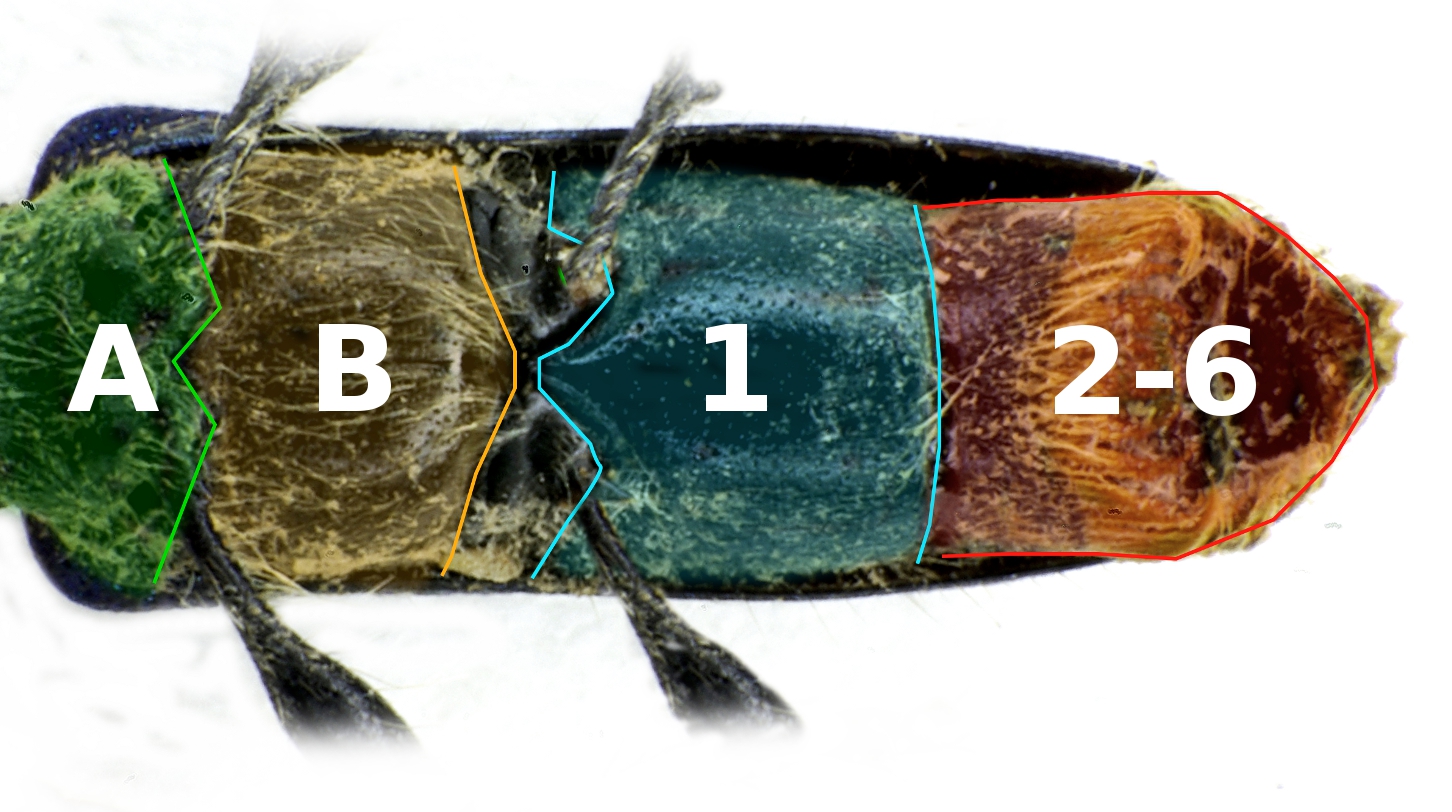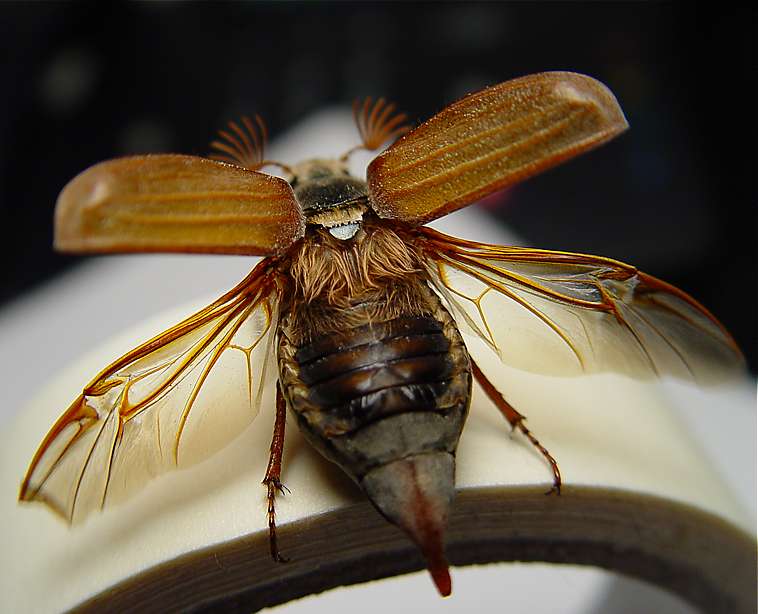|
Kachinus
''Kachinus'' is an extinct genus of ant-like stone beetle in the family Staphylinidae containing the single species ''Kachinus antennatus''. History and classification The type species, ''K. antennatus'', is known from only the holotype, a single, complete adult, now deposited in the American Museum of Natural History as specimen number "AMNH Bu-113". The amber specimen is from deposits in Kachin State, Tanai Village, northwest of Myitkyina, Myanmar. The holotype was first studied by Stylianos Chatzimanolis of the University of Tennessee, Michael S. Engel, Michael Engel of the University of Kansas, and Alfred F. Newton, Alfred Newton of the Field Museum. Chatzimanolis, Engel and Newton published their 2010 Type (biology), type description for ''K. antennatus'' in the journal ''Cretaceous Research''. The genus name is a masculine derivation of the Kachin State in Northern Myanmar where the amber containing the type specimen was unearthed. The species name ''antennatus'' is La ... [...More Info...] [...Related Items...] OR: [Wikipedia] [Google] [Baidu] |
Scydmaeninae
Scydmaeninae are a subfamily of small beetles, commonly called ant-like stone beetles or scydmaenines. These beetles occur worldwide, and the subfamily includes some 4,500 species in about 80 genera. Established as a family, they were reduced in status to a subfamily of Staphylinidae in 2009 Many scydmaenine species have a narrowing between head and thorax and thorax and abdomen, resulting in a passing resemblance to ants that inspires their common name. The largest measure just 3 millimeters long, while some very small species only reach half a millimeter in length. Scydmaenids typically live in leaf litter and rotting logs in forests, preferring moist habitats. A number of types are known to feed on oribatid mites, using "hole scraping" and "cutting" techniques to get through the mite's hard shells. In addition to the two living subfamilies, the prehistoric subfamily Hapsomelinae, known only from fossils, has been placed here. Selected genera *'' Cephennium'' *'' Elacatopho ... [...More Info...] [...Related Items...] OR: [Wikipedia] [Google] [Baidu] |
Ant-like Stone Beetle
Scydmaeninae are a subfamily of small beetles, commonly called ant-like stone beetles or scydmaenines. These beetles occur worldwide, and the subfamily includes some 4,500 species in about 80 genera. Established as a family, they were reduced in status to a subfamily of Staphylinidae in 2009 Many scydmaenine species have a narrowing between head and thorax and thorax and abdomen, resulting in a passing resemblance to ants that inspires their common name. The largest measure just 3 millimeters long, while some very small species only reach half a millimeter in length. Scydmaenids typically live in leaf litter and rotting logs in forests, preferring moist habitats. A number of types are known to feed on oribatid mites, using "hole scraping" and "cutting" techniques to get through the mite's hard shells. In addition to the two living subfamilies, the prehistoric subfamily Hapsomelinae, known only from fossils, has been placed here. Selected genera *''Cephennium'' *'' Elacat ... [...More Info...] [...Related Items...] OR: [Wikipedia] [Google] [Baidu] |
Upper Cretaceous
The Late Cretaceous (100.5–66 Ma) is the younger of two epochs into which the Cretaceous Period is divided in the geologic time scale. Rock strata from this epoch form the Upper Cretaceous Series. The Cretaceous is named after ''creta'', the Latin word for the white limestone known as chalk. The chalk of northern France and the white cliffs of south-eastern England date from the Cretaceous Period. Climate During the Late Cretaceous, the climate was warmer than present, although throughout the period a cooling trend is evident. The tropics became restricted to equatorial regions and northern latitudes experienced markedly more seasonal climatic conditions. Geography Due to plate tectonics, the Americas were gradually moving westward, causing the Atlantic Ocean to expand. The Western Interior Seaway divided North America into eastern and western halves; Appalachia and Laramidia. India maintained a northward course towards Asia. In the Southern Hemisphere, Australia and A ... [...More Info...] [...Related Items...] OR: [Wikipedia] [Google] [Baidu] |
Latin
Latin (, or , ) is a classical language belonging to the Italic branch of the Indo-European languages. Latin was originally a dialect spoken in the lower Tiber area (then known as Latium) around present-day Rome, but through the power of the Roman Republic it became the dominant language in the Italian region and subsequently throughout the Roman Empire. Even after the fall of Western Rome, Latin remained the common language of international communication, science, scholarship and academia in Europe until well into the 18th century, when other regional vernaculars (including its own descendants, the Romance languages) supplanted it in common academic and political usage, and it eventually became a dead language in the modern linguistic definition. Latin is a highly inflected language, with three distinct genders (masculine, feminine, and neuter), six or seven noun cases (nominative, accusative, genitive, dative, ablative, and vocative), five declensions, four ... [...More Info...] [...Related Items...] OR: [Wikipedia] [Google] [Baidu] |
Sternum (arthropod Anatomy)
The sternum (pl. "sterna") is the ventral portion of a segment of an arthropod thorax or abdomen. In insects, the sterna are usually single, large sclerites, and external. However, they can sometimes be divided in two or more, in which case the subunits are called sternites, and may also be modified on the terminal abdominal segments so as to form part of the functional genitalia, in which case they are frequently reduced in size and development, and may become internalized and/or membranous. For a detailed explanation of the terminology, see Kinorhynchs have tergal and sternal plates too, though seemingly not homologous with those of arthropods.Sørensen, M. V. et al. Phylogeny of Kinorhyncha based on morphology and two molecular loci. PLoS One 10, 1–33 (2015). Ventrites are externally visible sternites. Usually the first sternite is covered up, so that vertrite numbers do not correspond to sternid numbers. The term is also used in other arthropod groups such as crustacea ... [...More Info...] [...Related Items...] OR: [Wikipedia] [Google] [Baidu] |
Elytra
An elytron (; ; , ) is a modified, hardened forewing of beetles (Coleoptera), though a few of the true bugs ( Hemiptera) such as the family Schizopteridae are extremely similar; in true bugs, the forewings are called hemelytra (sometimes alternatively spelled as "hemielytra"), and in most species only the basal half is thickened while the apex is membranous, but when they are entirely thickened the condition is referred to as "coleopteroid". An elytron is sometimes also referred to as a shard. Description The elytra primarily serve as protective wing-cases for the hindwings underneath, which are used for flying. To fly, a beetle typically opens the elytra and then extends the hindwings, flying while still holding the elytra open, though many beetles in the families Scarabaeidae and Buprestidae can fly with the elytra closed (e.g., most Cetoniinae; ). In a number of groups, the elytra are reduced to various degrees, (e.g., the beetle families Staphylinidae and Ripiphoridae), o ... [...More Info...] [...Related Items...] OR: [Wikipedia] [Google] [Baidu] |
Occiput
The occipital bone () is a cranial dermal bone and the main bone of the occiput (back and lower part of the skull). It is trapezoidal in shape and curved on itself like a shallow dish. The occipital bone overlies the occipital lobes of the cerebrum. At the base of skull in the occipital bone, there is a large oval opening called the foramen magnum, which allows the passage of the spinal cord. Like the other cranial bones, it is classed as a flat bone. Due to its many attachments and features, the occipital bone is described in terms of separate parts. From its front to the back is the basilar part, also called the basioccipital, at the sides of the foramen magnum are the lateral parts, also called the exoccipitals, and the back is named as the squamous part. The basilar part is a thick, somewhat quadrilateral piece in front of the foramen magnum and directed towards the pharynx. The squamous part is the curved, expanded plate behind the foramen magnum and is the largest par ... [...More Info...] [...Related Items...] OR: [Wikipedia] [Google] [Baidu] |
Pronotum
The prothorax is the foremost of the three segments in the thorax of an insect, and bears the first pair of legs. Its principal sclerites (exoskeletal plates) are the pronotum ( dorsal), the prosternum ( ventral), and the propleuron ( lateral) on each side. The prothorax never bears wings in extant insects (except in some cases of atavism), though some fossil groups possessed wing-like projections. All adult insects possess legs on the prothorax, though in a few groups (e.g., the butterfly family Nymphalidae) the forelegs are greatly reduced. In many groups of insects, the pronotum is reduced in size, but in a few it is hypertrophied, such as in all beetles (Coleoptera). In most treehoppers (family Membracidae, order Hemiptera), the pronotum is expanded into often fantastic shapes that enhance their camouflage or mimicry. Similarly, in the Tetrigidae, the pronotum is extended backward to cover the flight wings, supplanting the function of the tegmina. See also * Glossary o ... [...More Info...] [...Related Items...] OR: [Wikipedia] [Google] [Baidu] |
Elytra
An elytron (; ; , ) is a modified, hardened forewing of beetles (Coleoptera), though a few of the true bugs ( Hemiptera) such as the family Schizopteridae are extremely similar; in true bugs, the forewings are called hemelytra (sometimes alternatively spelled as "hemielytra"), and in most species only the basal half is thickened while the apex is membranous, but when they are entirely thickened the condition is referred to as "coleopteroid". An elytron is sometimes also referred to as a shard. Description The elytra primarily serve as protective wing-cases for the hindwings underneath, which are used for flying. To fly, a beetle typically opens the elytra and then extends the hindwings, flying while still holding the elytra open, though many beetles in the families Scarabaeidae and Buprestidae can fly with the elytra closed (e.g., most Cetoniinae; ). In a number of groups, the elytra are reduced to various degrees, (e.g., the beetle families Staphylinidae and Ripiphoridae), o ... [...More Info...] [...Related Items...] OR: [Wikipedia] [Google] [Baidu] |
Scydmaenitae
Scydmaenitae is a supertribe under subfamily Scydmaeninae Scydmaeninae are a subfamily of small beetles, commonly called ant-like stone beetles or scydmaenines. These beetles occur worldwide, and the subfamily includes some 4,500 species in about 80 genera. Established as a family, they were reduced in .... It includes tribus such as '' Glandulariini'' and '' Scydmaenini''. References Inline citations Primary references * Additional references * * 2016. ''Microscydmus trianguliceps'' and ''Pseudoeudesis sulcata'' transferred to ''Afroeudesis'' (Coleoptera: Staphylinidae: Scydmaeninae). Zootaxa 4173(2): 163–173. DOI10.11646/zootaxa.4173.2.7 * ; 1998: World catalog of the genera of Scydmaenidae (Coleoptera). ''Koleopterologische Rundschau'', 68: 137–165. External links * * {{Taxonbar, from=Q10599240 Taxa named by William Elford Leach Scydmaeninae Supertribes ... [...More Info...] [...Related Items...] OR: [Wikipedia] [Google] [Baidu] |
Eutheiini
Eutheiini is a tribe of beetles belonging to the family Staphylinidae. Genera: * † '' Archeutheia'' Jałoszyński & Peris, 2016 * ''Eutheia ''Eutheia'' is a genus of beetles belonging to the family Staphylinidae The rove beetles are a family (Staphylinidae) of beetles, primarily distinguished by their short elytra (wing covers) that typically leave more than half of their abdomina ...'' Stephens, 1830 * '' Euthiconus'' Reitter, 1882 * '' Euthiopsis'' Müller, G., 1925 * '' Paeneutheia'' Jałoszyński, 2003 * '' Paraneseuthia'' Franz, 1986 * '' Veraphis'' Casey, 1897 * † '' Vertheia'' Jałoszyński & Perkovsky, 2016 References {{Taxonbar, from=Q21226582 Staphylinidae Beetle tribes ... [...More Info...] [...Related Items...] OR: [Wikipedia] [Google] [Baidu] |





_Figure_2.jpg)